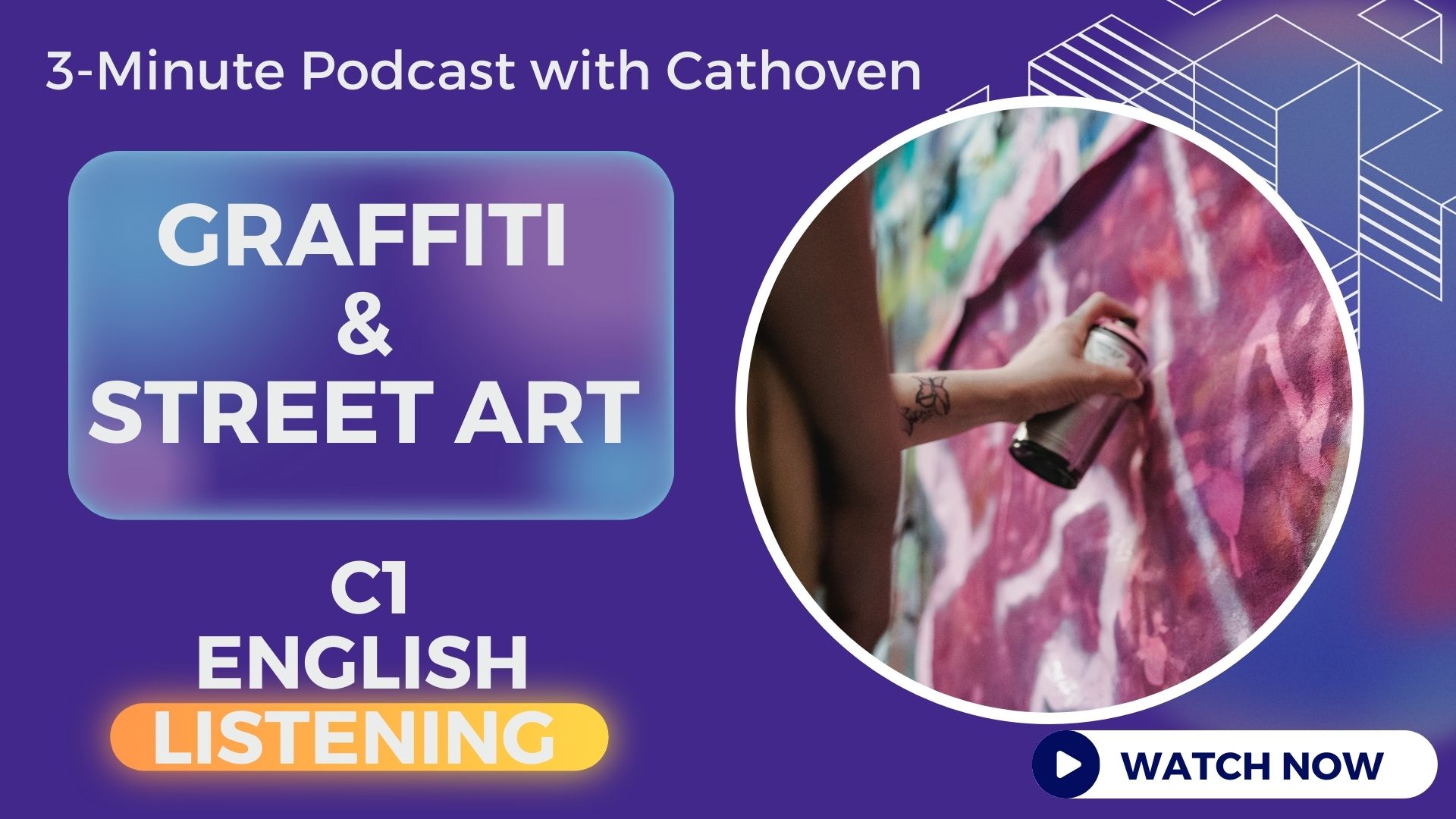Graffiti and Street Art
How to use this listening lesson:
- Listen to the Material
- Check the Transcript
- Solve the Questions
- Review Answer Keys and Explanations
How to use this listening lesson
- Listen to the Material
- Check the Transcript
- Solve the Questions
- Review Answer Keys and Explanations
Transcript
Transcript
Street art and graffiti often evoke polarized opinions, yet both serve as powerful tools for urban expression. This art form transforms mundane public spaces into vibrant visual narratives, challenging traditional notions of art and spatial ownership. The distinction between street art and graffiti can be nebulous, with graffiti usually characterized by its rebellious nature and emphasis on text. While street art encompasses a broader range of styles and media, anonymous artists often employ the urban canvas to convey social and political commentary, providing a voice to underrepresented communities. They transform drab walls into canvases that spark dialogue, provoke thought, and sometimes foster social change. While some view these works as acts of vandalism, others perceive them as legitimate and meaningful contributions to the cultural landscape. Cities around the world have become meccas for street art, with some even commissioning artists to create public murals. This institutional support highlights a growing recognition of street art’s cultural significance and potential to enhance urban environments. Conversely, unauthorized graffiti remains controversial. Often prompting debates about property rights and public space utilization. Street art’s ephemeral nature further complicates its reception. Works can be meticulously crafted, yet susceptible to rapid deterioration or removal. This transience imbues street art with a poignant impermanence, a characteristic distinct from traditional, gallery-conserved artworks. The very act of creating street art can be both a personal endeavour and a public spectacle with real-time audience engagement. Technological advancements have also amplified the reach and impact of street art, with social media platforms allowing artists to share their work globally. This digital proliferation has democratized art consumption and appreciation, though it also raises questions about the commodification and commercialization of what was once purely subversive. Ultimately, street art and graffiti continue to redefine the boundaries of public and private space, challenging and enriching urban cultures worldwide.
Text Analysis
General Level: C1.6
Vocabulary: C1.4
Verb Form: A1.9
Clause: B1.8
Prosody: C2.2
Phrases and Idioms
Lemma | Count | Sentences |
Mecca for | 1 | ·Cities around the world have become meccas for street art, with some even commissioning artists to create public murals. |
art form | 1 | · This art form transforms mundane public spaces into vibrant visual narratives, challenging traditional notions of art and spatial ownership. |
imbue (someone or something) with (something) | 1 | · This transience imbues street art with a poignant impermanence, a characteristic distinct from traditional, gallery-conserved artworks. |
serve as (something) | 1 | · Street art and graffiti often evoke polarized opinions, yet both serve as powerful tools for urban expression. |
susceptible to (something) | 1 | · Works can be meticulously crafted, yet susceptible to rapid deterioration or removal. |
Listening Comprehension Exercises
True / False
- Graffiti is primarily recognized by its rebellious nature and textual emphasis.
- Anonymous artists use urban spaces to solely promote their personal brands.
- Some cities officially support street art by commissioning murals.
- Unauthorized graffiti is unanimously accepted as a meaningful contribution to the cultural landscape.
- Technological advancements have limited the reach of street art to local audiences.
It's Your Turn!
Create your multiple choice questions for this listening lesson just in seconds!
Step 1: Click the button to copy the YouTube link
Step 2: Go to
Step 3: Paste the link
Select question type
Click “Create” and your questions will be ready in seconds!
Short Answer Questions
- How do street art and graffiti differ in terms of their nature?
- What role do anonymous street artists often play in urban spaces?
- Why is street art considered to have a ‘poignant impermanence’?
- How has social media influenced street art?
- What is the controversy surrounding unauthorized graffiti?
Answer Key
True / False Answers
- Answer: True
Explanation: The text states that graffiti is known for its rebellious quality and focus on text, distinguishing it from street art.
Answer location: “The distinction between street art and graffiti can be nebulous, with graffiti usually characterized by its rebellious nature and emphasis on text.”
- Answer: False
Explanation: The text explains that anonymous artists use urban spaces to convey social and political messages, not just to promote personal brands.
Answer location: “Anonymous artists often employ the urban canvas to convey social and political commentary, providing a voice to underrepresented communities.”
- Answer: True
Explanation: The text indicates that some cities officially support street art by commissioning public murals.
Answer location: “Cities around the world have become meccas for street art, with some even commissioning artists to create public murals.”
- Answer: False
Explanation: The text describes unauthorized graffiti as controversial and a subject of debates, showing it is not universally accepted.
Answer location: “Conversely, unauthorized graffiti remains controversial. Often prompting debates about property rights and public space utilization.”
- Answer: False
Explanation: The text mentions that technology has expanded the reach of street art globally, not limited it.
Answer location: “Technological advancements have also amplified the reach and impact of street art, with social media platforms allowing artists to share their work globally.”
It's Your Turn!
Create your multiple choice questions for this listening lesson just in seconds!
Step 1: Click the button to copy the YouTube link
Step 2: Go to
Step 3: Paste the link
Select question type
Click “Create” and your questions will be ready in seconds!
Short Answer Answers
- Answer: Graffiti is characterized by its rebellious nature and emphasis on text.
Explanation: The text specifies that graffiti is typically rebellious and text-focused, distinguishing it from street art, which encompasses broader styles and media.
Answer location: “The distinction between street art and graffiti can be nebulous, with graffiti usually characterized by its rebellious nature and emphasis on text.”
- Answer: Convey social and political commentary, providing a voice to underrepresented communities.
Explanation: The text mentions that anonymous artists use urban spaces to share social and political messages and represent underrepresented groups.
Answer location: “Anonymous artists often employ the urban canvas to convey social and political commentary, providing a voice to underrepresented communities.”
- Answer: Works can be meticulously crafted, yet susceptible to rapid deterioration or removal.
Explanation: Street art’s temporary nature, as it may quickly degrade or be removed, creates a sense of impermanence described as poignant.
Answer location: “Works can be meticulously crafted, yet susceptible to rapid deterioration or removal. This transience imbues street art with a poignant impermanence…”
- Answer: Amplified the reach and impact of street art, allowing artists to share their work globally.
Explanation: Social media helps artists distribute their work widely, thus increasing the influence and audience for street art.
Answer location: “Technological advancements have also amplified the reach and impact of street art, with social media platforms allowing artists to share their work globally.”
- Answer: Property rights and public space utilization.
Explanation: Unauthorized graffiti triggers debates about who has the right to use public spaces and to whom these spaces belong.
Answer location: “Conversely, unauthorized graffiti remains controversial, often prompting debates about property rights and public space utilization.”



